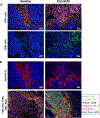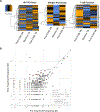Intratumoral G100, a TLR4 Agonist, Induces Antitumor Immune Responses and Tumor Regression in Patients with Merkel Cell Carcinoma
- PMID: 30093453
- PMCID: PMC6368904
- DOI: 10.1158/1078-0432.CCR-18-0469
Intratumoral G100, a TLR4 Agonist, Induces Antitumor Immune Responses and Tumor Regression in Patients with Merkel Cell Carcinoma
Abstract
Purpose: G100 is a toll-like receptor 4 (TLR4) agonist that triggers innate and adaptive antitumor immune responses in preclinical models. This pilot study assessed the safety, efficacy, and immunologic activity of intratumoral (IT) administration of G100 in patients with Merkel cell carcinoma (MCC).
Patients and methods: Patients with locoregional MCC (n = 3; cohort A) received neoadjuvant IT G100 (2 weekly doses at 5 μg/dose) followed by surgery and radiotherapy; patients with metastatic MCC (n = 7; cohort B) received 3 doses in a 6-week cycle and could receive additional cycles with/without radiotherapy.
Results: IT G100 was safe and feasible in both neoadjuvant and metastatic settings. Treatment-related adverse events were mostly grade 1 or 2 injection-site reactions. IT G100 led to increased inflammation in the injected tumors with infiltration of CD8+ and CD4+ T cells and activation of immune-related genes. These proinflammatory changes were associated with local tumor regression and appeared to promote systemic immunity. All 3 cohort A patients successfully completed therapy; 2 patients remain recurrence free at 44+ and 41+ months, including 1 with a pathologic complete response after G100 alone. In cohort B, 2 patients achieved sustained partial responses, both lasting 33+ months after 2 cycles of therapy.
Conclusions: In this first-in-human study, IT G100 induced antitumor immune responses, demonstrated acceptable safety, and showed encouraging clinical activity.See related commentary by Marquez-Rodas et al., p. 1127.
©2018 American Association for Cancer Research.
Conflict of interest statement
Figures




Comment in
-
For Whom the Cell Tolls? Intratumoral Treatment Links Innate and Adaptive Immunity.Clin Cancer Res. 2019 Feb 15;25(4):1127-1129. doi: 10.1158/1078-0432.CCR-18-2690. Epub 2018 Sep 27. Clin Cancer Res. 2019. PMID: 30262506
References
-
- Balkwill FR, Capasso M, Hagemann T. The tumor microenvironment at a glance. J Cell Sci. 2012;125:5591–6. - PubMed
-
- Fridman WH, Pagès F, Sautès-Fridman C, Galon J. The immune contexture in human tumours: impact on clinical outcome. Nat Rev Cancer. 2012;12:298–306. - PubMed
-
- Hanahan D, Weinberg RA. Hallmarks of cancer: The next generation. Cell. 2011. page 646–74. - PubMed
-
- Aznar MA, Tinari N, Rullán AJ, Sánchez-Paulete AR, Rodriguez-Ruiz ME, Melero I. Intratumoral Delivery of Immunotherapy-Act Locally, Think Globally. J Immunol 2017;198:31–9. - PubMed
Publication types
MeSH terms
Substances
Grants and funding
LinkOut - more resources
Full Text Sources
Other Literature Sources
Research Materials

